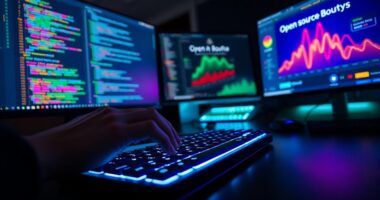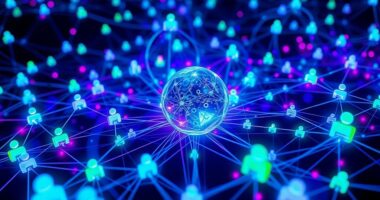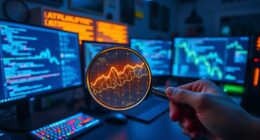DAOs, NFTs, and DeFi are the core building blocks of the Web3 ecosystem, transforming how you own, govern, and access financial services online. DAOs enable you to participate in decision-making through token voting, while NFTs certify your digital ownership of unique assets like art or real estate. DeFi offers decentralized financial services such as lending and trading without traditional intermediaries. Together, these elements create a more transparent, inclusive, and innovative digital environment—discover how they can reshape your digital experience.
Key Takeaways
- DAOs enable decentralized decision-making and collective ownership within the Web3 ecosystem through token-based governance.
- NFTs certify digital ownership of unique assets, transforming asset valuation and providing proof of authenticity.
- DeFi offers decentralized financial services like lending, borrowing, and trading without traditional intermediaries.
- Cross chain bridges connect multiple blockchains, enhancing interoperability and expanding ecosystem functionalities.
- Together, DAOs, NFTs, and DeFi form an interconnected network that promotes transparency, inclusivity, and innovative economic models.

Have you ever wondered how blockchain technology is reshaping the way we organize, own, and exchange value? It’s transforming traditional systems into decentralized networks where control is distributed among participants rather than centralized authorities. At the heart of this revolution are DAOs, NFTs, and DeFi — the building blocks of the Web3 ecosystem. These innovations work together to create more transparent, efficient, and user-driven digital environments.
Blockchain tech is transforming how we own, exchange, and organize value through DAOs, NFTs, and DeFi.
DAOs, or Decentralized Autonomous Organizations, allow you to participate directly in decision-making processes. Instead of relying on a hierarchical structure, you wield influence through token governance—where holding tokens grants voting rights on proposals that shape the platform’s future. This model promotes collective ownership and aligns interests among members. As DAOs grow, they also leverage cross chain bridges to expand their reach and functionality. These bridges enable seamless asset and data transfer between different blockchains, ensuring that your tokens and governance rights are not limited to a single network. By connecting multiple chains, DAOs can tap into diverse ecosystems, increase liquidity, and foster collaboration across platforms, making the ecosystem more resilient and versatile.
NFTs, or Non-Fungible Tokens, add a new dimension to digital ownership. They certify unique assets like art, music, or virtual real estate, giving creators and collectors a secure way to prove authenticity and provenance. Unlike cryptocurrencies, NFTs are indivisible, making each one distinct. This uniqueness fuels new economic models and ownership rights, transforming how we value digital assets. Meanwhile, DeFi, or Decentralized Finance, opens up financial services—such as lending, borrowing, and trading—without traditional intermediaries. You can earn interest, participate in liquidity pools, or stake your tokens to earn rewards, all on open, permissionless platforms. The interoperability of these systems depends heavily on cross chain bridges, which connect disparate DeFi protocols across different blockchains, allowing you to move assets freely and access broader markets.
Additionally, implementing effective goal tracking strategies can enhance your ability to navigate and contribute to this rapidly evolving ecosystem.
Together, token governance, cross chain bridges, NFTs, and DeFi create a web of interconnected opportunities. They empower you to have more control over your digital assets, participate in governance, and explore new economic landscapes. This interconnected ecosystem is designed to be more inclusive and adaptable, breaking down the barriers imposed by traditional finance and centralized control. As these components continue to evolve, they’re shaping a future where your ownership and participation are more direct, transparent, and impactful. Whether you’re investing, creating, or governing, understanding how these building blocks work together is key to steering the Web3 revolution.
Frequently Asked Questions
How Do DAOS Ensure Transparent Decision-Making?
You guarantee transparent decision-making in a DAO through community governance and voting mechanisms. These structures allow every member to participate openly, view proposals, and cast votes on important issues. By recording all activities on a blockchain, the process remains visible and tamper-proof. This openness fosters trust, as everyone can verify decisions, ensuring that the organization operates fairly and transparently in line with the community’s consensus.
What Are the Risks of Investing in NFTS?
Investing in NFTs can feel like sailing into unpredictable storms—market volatility keeps prices bouncing wildly, and NFT valuation can fluctuate like a rollercoaster. You risk losing money if values plummet suddenly or if the NFT doesn’t hold its perceived uniqueness. Plus, the lack of regulation adds a fog of uncertainty. Be prepared for emotional turbulence and only invest what you can afford to lose in this wild digital ocean.
How Does Defi Compare to Traditional Banking?
DeFi offers a more accessible and flexible alternative to traditional banking by enabling peer-to-peer lending and borrowing with cryptocurrency. You can participate directly without intermediaries, often benefiting from lower fees and faster transactions. As cryptocurrency adoption grows, DeFi platforms become more mainstream, giving you greater control over your finances. However, always remember the risks involved, like volatility and security issues, when compared to the stability of traditional banks.
Can NFTS Be Used Beyond Digital Art?
Yes, NFTs can be used beyond digital art. You can leverage NFT utility for digital ownership of assets like music, videos, virtual goods, and even real estate. They provide proof of authenticity and ownership, enabling new ways to buy, sell, or transfer items securely online. This expands their use cases far beyond art, creating innovative opportunities for creators, collectors, and businesses in various industries.
How Do Regulatory Frameworks Impact Defi Platforms?
Regulatory frameworks considerably impact DeFi platforms by enforcing compliance and reducing legal ambiguity. You must navigate evolving laws that can impose restrictions, such as KYC and AML requirements, which may limit decentralization. These regulations can create uncertainty, making it harder for you to operate freely. Staying informed about legal changes helps you adapt, ensuring your DeFi activities remain compliant and minimizing risks associated with regulatory enforcement.
Conclusion
Think of DAOs, NFTs, and DeFi as the pillars holding up the Web3 skyscraper. Together, they create a new digital city where trust, ownership, and finance are decentralized and democratized. As you explore this landscape, remember you’re not just a spectator but an architect shaping the future. These building blocks are the seeds of innovation—plant them wisely, and you’ll help grow a resilient, open, and vibrant Web3 universe.








